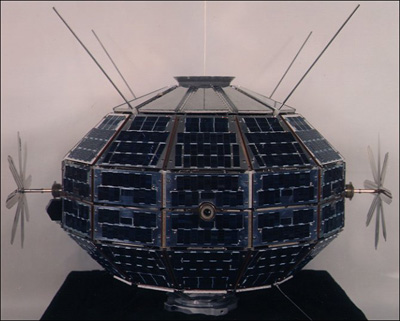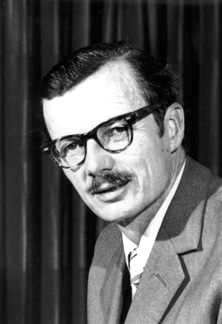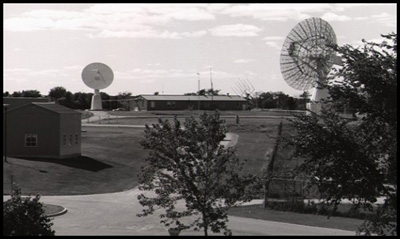
by John Palimaka Telesat Canada
published in IEEE Canadian Review - Fall 1992
ABSTRACT
Canada entered into the Space Age thirty years ago with the launch of the Alouette I satellite. Early success in the field of space science led to strong Canadian programs in satellite communications and remote sensing, through the cooperative effort of government and industry.
 |
. |
| A view of the Alouette satellite showing the four telemetry antennas and two of the four STEM (Storable Tubular Extendible Member) sounding antennas which were deployed on orbit. The satellite is about one metre in diameter. |
A MILESTONE OF ELECTRICAL ENGINEERING
Exactly thirty years ago, on September 29, 1962 the Canadian-built Alouette I satellite was launched into orbit aboard a Thor-Agena launch vehicle from the U.S. Pacific Missile Test Range in California. It was the first satellite launched into space which was built entirely by a country other that the U.S. or the U.S.S.R. The Alouette/ISIS Program consisted of four satellites and associated ground-based data analysis equipment. After the successful launch of Alouette I, Alouette II was launched in 1965, ISIS I in 1969 and ISIS II in 1971 (ISIS is an acronym for "International Satellite for Ionospheric Studies"). Both Alouette satellites were used for ten years, and the ISIS satellites were used until 1984, when the program was concluded. Japan was authorized to use the ISIS satellites and continued to do so until the late 1980's. By 1980, over 1100 papers and reports were published, and data continues to be received from the two ISIS satellites - more than 20 years after the start of the program.
Early in the history of space exploration, Canadian researchers in space science concentrated on the study of the earth's upper atmosphere and the ionosphere. This was due to the need to understand the characteristics of radio communication in the Canadian North. This area of study was not as predominant a component of the space science effort of other countries and therefore the Alouette/ISIS Program was able to make a major and unique contribution.
This effort led to the realization that a satellite communications system would be the best way to provide a communications infrastructure for all of Canada, including the North. A very concrete result of this was the launch by NASA for Telesat Canada of Anik A1, a telecommunications satellite designed to satisfy Canada's domestic communications requirements (Ref. 1).
 |
. |
| John H. Chapman. |
JOHN H. CHAPMAN
The Alouette/ISIS Program was initiated by Dr. John H. Chapman, who at his untimely death in 1979 at the age of 58, was the Assistant Deputy Minister for Space in the Canadian Department of Communications.At the end of 1958, a proposal was submitted by Canada to NASA for a scientific satellite to act as an ionospheric topside sounder to study the effects of the ionosphere on radio communications in the North, from an orbital altitude of approximately 1,000 km. As Canadian coordinator of the Alouette Program, John Chapman was instrumental in the successful launch of the Alouette I satellite (Ref. 2).
In June 1969, a special issue of the Proceedings of the IEEE was devoted entirely to topside sounding of the ionosphere and the great majority of the papers in this issue sprung from the analysis of data from the Alouette satellites (Ref. 3).
John Chapman was convinced of the need to develop the capability to design and build space hardware in Canadian industry and to move away from the practice of relying solely on the expertise of the government laboratories. As a result, Alouette II and the ISIS satellites were built, with steadily increasing participation by Canadian industry.
TELECOMMUNICATIONS SATELLITES
In 1967, a report was produced by a committee chaired by John Chapman, which recommended a redirection of Canada's effort in space from space science and toward telecommunications and land survey. The culmination of this was the launch in 1972 of Anik A1. With the successful placement of this satellite on station, approximately 36,000 km above the equator, Canada became the first country to have a domestic geostationary communications satellite system. The Anik A series of satellites was built by Hughes Aircraft Corporation of the United States.
 |
. |
| This photograph was taken in 1974 and shows the Alouette/ISIS tracking antenna (on the right), a yagi array antenna of the earlier generation and a dish antenna of later design (on the left). |
THE ALOUETTE/ISIS TRACKING ANTENNA
As a reminder of the Alouette/ISIS Program, an effort is being made to preserve an 18-metre diameter tracking antenna at the Shirley Bay Research Centre near Ottawa, Ontario. This antenna was used to receive data from the Alouette I, ISIS I and ISIS II satellites. The site of the antenna us occupied by three agencies of the Canadian Federal Government: the Communications Research Centre, the Defense Research Establishment Ottawa and the David Florida Laboratory of the Canadian Space Agency. The three agencies have jointly undertaken a feasibility study of the restoration and interpretation of the Alouete/ISIS tracking antenna. The agencies propose to create an interpretation centre at the entrance to the Shirley Bay Research Centre, along a major regional road just west of Ottawa. This relocation of the antenna will increase the antenna's visibility and permit public access to the display.
During the past year the IEEE Ottawa Section has submitted a nomination to the IEEE Centre for the History of Electrical Engineering to have the Alouette/ISIS Program designated as a Milestone of Electrical Engineering. That designation is expected to be awarded soon.
The Alouette/ISIS Program had previously received recognition in Canada as an engineering achievement. In 1987, the centennial year of engineering in Canada, the Engineering Centennial Board selected Alouette I as one of the ten greatest achievements in Canadian Engineering in the past century.
Doris Jelly, Curator of the new "Canada in Space Exhibit", which has recently opened at the National Museum of Science and Technology in Ottawa writes that: "The success of the Alouette/ISIS Program led to the growth of satellite technology in Canadian industry, and the further development of satellite systems for communications, meteorology, resource surveys and other related programs during the 1970's. Communications satellites soon became the most important applications of space technology. Their introduction resulted in a communications revolution, the effect of which has been likened to the airplane on transportation." (Ref. 4)
It is hoped that the Milestone designation and the preservation of the Alouette/ISIS antenna will promote a wider knowledge about the accomplishments of Canadian researchers and satellite hardware manufacturers in the early years of the Space Age.
REFERENCES
J. Almond, C.A. Franklin and E.S. Warren, 1976, A Perspective on the Canadian Satellite Program, Canadian Electrical Engineering Journal, Volume 1, Number 1, Pages 47-60.
ABOUT THE AUTHOR
John Palimaka studied Engineering Science, Physics and Astronomy at the University of Toronto, receiving a B.Sc. degree in 1976. He received an M.Sc. degree in Physics (Radio Astronomy) from Queen's University at Kingston in 1979. Now at Telesat Canada, he is a Program Manager in the Flight Dynamics Systems Group. He is a Past-Chairman of the IEEE Ottawa Section (1991-92).